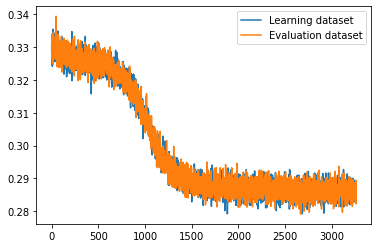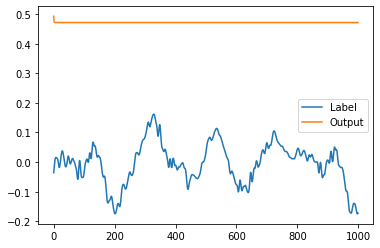I am trying to train an lstm model for music generation, and now i am at a stage of “Get somewhat sane results out of that pile of algebra”
At first i tried a model of 1 LSTM → 1 linear layer, and loss fell to ~0.02 and then remained stable, but then, when i tried to do 2LSTM → 2 linear layers, loss didnt fall lower than ~0.2, but i expected it to be even lower, because of increased model complexity
2LSTM → 2Linear graph (sampled every batch, 1988 batches/epoch):

Classes:
class LSTMModule(nn.Module):
"""
Wrapper for nn.LSTM for easier understanding
"""
def __init__(self, in_features = 1, out_features = 1, num_layers = 1, activation = None, device = 'cuda'):
super().__init__()
self.lstmlayer = nn.LSTM(in_features,out_features,num_layers).to(device)
self.activation = activation
self.device = device
def forward(self, input_val, hidden = None):
input_val = input_val.to(self.device)
if hidden is not None:
hidden = hidden.device(self.device)
output,hidden = self.lstmlayer(input_val, hidden)
#if self.activation is not None:
#output = self.activation(output) #turns out, tanh is built into LSTM, nice
return output, hidden
class LinearModule(nn.Module):
"""
Module for sequence processing with nn.Linear layers
"""
def __init__(self,in_features = 1, out_features = 1, batch_first = False, num_layers = 1, activation = None, device = 'cuda'):
super().__init__()
if num_layers == 0:
raise Exception("Linear module cant have 0 layers")
self.layers = [nn.Linear(in_features,out_features).to(device) for i in range(0,num_layers)]
self.activation = activation
self.device = device
self.batch_first = batch_first
def forward(self, input_val):
if not self.batch_first: #reshape into (batches,seq_length,features), if not already
output = input_val.reshape(input_val.size(1),input_val.size(0),1)
else:
output = input_val
output = output.to(self.device)
for i in range(0,len(self.layers)): #iterate over all layers in module, 2 in my case
output = self.layers[i](output)
if self.activation is not None:
output = self.activation(output)
return output
class network(nn.Module):
def __init__(self, input_size=1, hidden_layer_size=1, output_size=1, seq_length_ = 1, batch_size_ = 128):
super().__init__()
#self.hidden_layer_size = hidden_layer_size
#self.batch_size = batch_size_
#self.seq_length = seq_length_
self.memory_module = LSTMModule(device = DEVICE, num_layers = 2)
self.linear_module = LinearModule(activation = nn.Tanh(),device = DEVICE, num_layers = 2)
def forward(self, input_seq):
lstm_output, _ = self.memory_module(input_seq)
output = self.linear_module(lstm_output)
return output.reshape(output.shape[1],output.shape[0],1) #reshape back to seq,batch,features
Is there something wrong with how my model is structured (module in module in model, iterating over linear layers in for loop), or is it just a local minima?
UPD:
Looked at models output, it is just a flat line:



I am starting to feel like i am doing something wrong